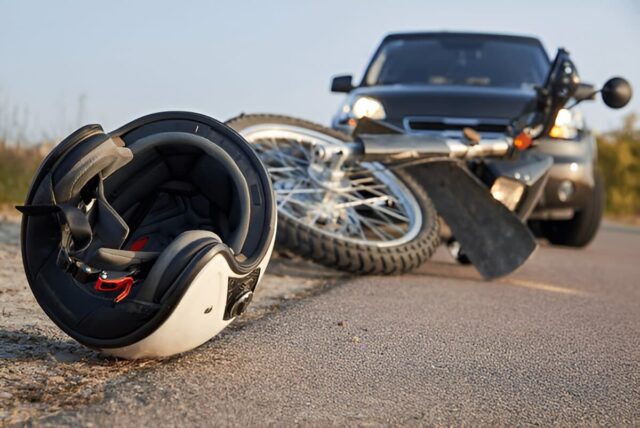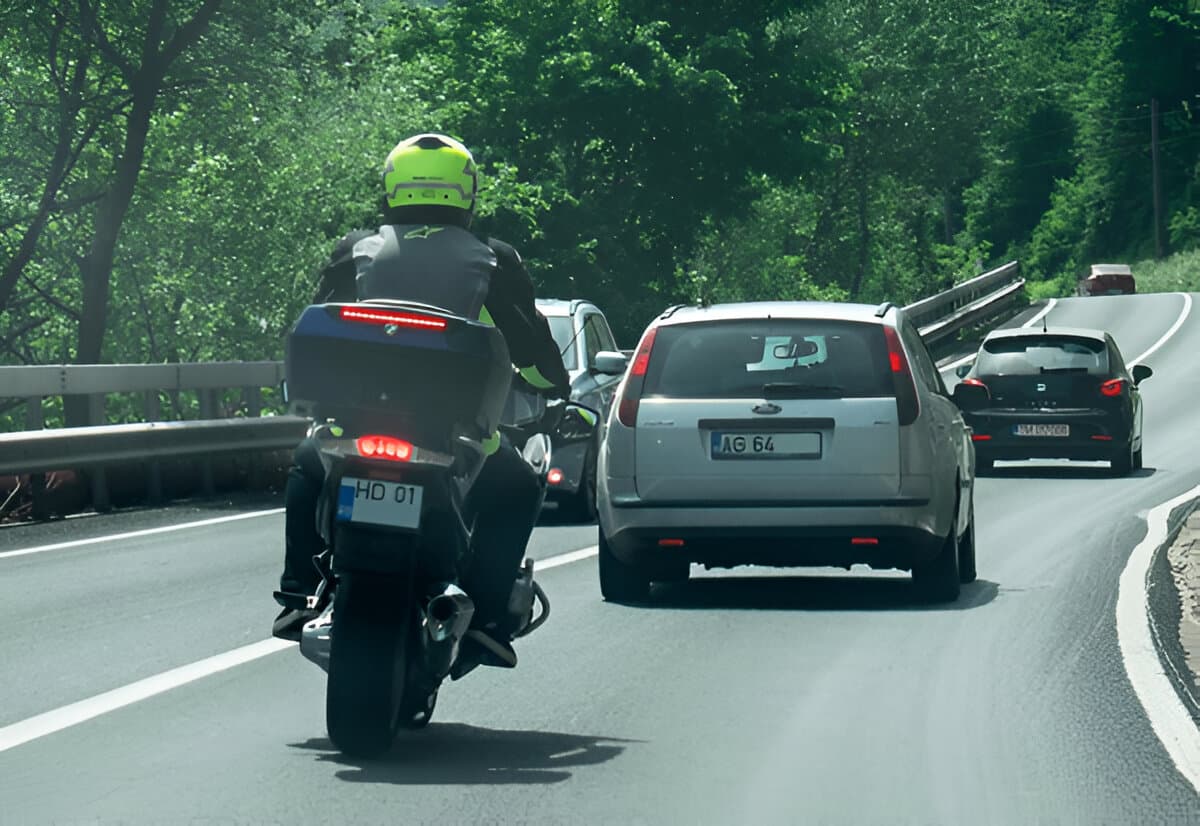Yes, you can still file a lawsuit even if you were lane splitting during your motorcycle accident in Arkansas. While lane splitting is illegal in Arkansas, breaking a traffic law doesn’t automatically make you 100% responsible for the crash or bar you from seeking compensation.
Arkansas follows comparative fault laws, meaning liability gets divided based on each party’s actual contribution to the accident. If another driver was texting, ran a red light, or failed to check their blind spot before merging, their negligence doesn’t disappear just because you were lane splitting. You might be found partially at fault for the illegal maneuver, but the other driver could bear primary responsibility for the collision itself.
This distinction matters enormously for your financial recovery. Even if you’re found 30% at fault for lane splitting, you could still recover 70% of your damages from the negligent driver. That could mean hundreds of thousands of dollars in medical bills, lost wages, and pain and suffering compensation.
If a negligent driver has injured you in a motorcycle accident, contact an Arkansas motorcycle accident lawyer at Caddell Reynolds Law Firm. We understand how Arkansas’s specific traffic and liability laws apply to these complex situations. For a free consultation to discuss your case, call us at (479) 782-5297.
Arkansas Law Prohibits Lane Splitting
The specific statute, Arkansas Code Annotated § 27-51-302, governs the use of marked traffic lanes. In plain English, this law gives a motorcycle the right to a full lane, just like any other vehicle. It also expressly forbids a motorcyclist from overtaking and passing another vehicle in the same lane. Furthermore, it prohibits operating a motorcycle between lanes of traffic or rows of vehicles.
This means that both common forms of the practice are illegal in Arkansas:
- Lane Splitting: Riding between lanes of moving traffic, usually at speed.
- Lane Filtering: Moving between lanes of stopped or slow-moving traffic, for example, at a red light.
While a few other states like California have legalized the practice to some degree, Arkansas has not followed that trend and maintains a more conservative stance.
How Does a Court Decide Who Is at Fault?
The 50% Bar Rule
The most important part of Arkansas’s modified comparative negligence system is the “50% bar rule.” In simple terms, you can only recover damages if a judge or jury finds that you were less than 50% at fault for the accident. If you are found to be 50% or more responsible for causing the crash, you lose the right to any compensation from the other driver.
How It Affects Your Compensation
If you are found to be partially at fault, but less than 50%, your total compensation will be reduced by your percentage of fault. This is a point that insurance adjusters will use to their advantage.
A Traffic Violation Doesn’t Automatically Erase the Other Driver’s Negligence
A frequent concern for riders is that since they were technically breaking the law, they will automatically be held responsible. However, a traffic violation does not give other drivers a license to be careless.
The legal concept of “negligence per se” comes into play here. This means that while breaking a safety law (like the one against lane splitting) can be used as evidence of your negligence, it is not the end of the story. The other driver still has a duty to operate their vehicle safely, and the actions of all parties will be investigated.
There are many ways another driver can be primarily at fault, even if you were splitting lanes. Examples include:
- An Unsafe Lane Change: This is perhaps the most common cause. A driver swerves into your path without checking their blind spot or signaling their intention. Under Arkansas Code Annotated § 27-51-104, an improper or unsafe lane change is a prohibited act.
- Distracted Driving: A driver who is texting, eating, adjusting the radio, or otherwise not paying attention to the road cannot react to their surroundings.
- Driving Under the Influence: If the driver was impaired by alcohol or drugs, their judgment, coordination, and reaction time were compromised, making them a danger to everyone.
- Sudden Stops or Turns: A driver who slams on their brakes for no reason or makes an abrupt turn without signaling can easily cause a collision.
- Opening a Car Door: In stopped traffic, a driver or passenger who suddenly opens their door into the path of a filtering motorcyclist could be held negligent.
The key is to demonstrate that the other driver’s careless or reckless action was the main reason the accident happened.
What Do You Need to Prove the Other Driver Was More Than 50% At Fault?
Because the insurance company will immediately focus on your lane splitting, building a strong case requires solid, persuasive evidence. Your lawyer must present a clear picture of how the other driver’s actions were the primary cause of the accident. Our firm focuses on gathering a wide range of evidence to build a compelling claim.
The Police Report
While the officer’s report will likely mention you were lane splitting, it also contains objective facts. These details include vehicle positions, points of impact, road conditions, witness contact information, and sometimes the officer’s initial assessment of fault.
Photos and Videos
There is no substitute for visual evidence. Photographs and video from the accident scene can powerfully illustrate how the crash occurred. We look for pictures of vehicle damage, skid marks, road debris, and your physical injuries. Footage from a dashcam or a helmet-mounted camera can be particularly compelling, as it can show the other driver’s dangerous maneuver in real time.
Eyewitness Testimony
Independent witnesses who saw the accident can provide an unbiased account of events. Their testimony can be invaluable in confirming that the other driver was speeding, swerving, or otherwise driving erratically just before the collision.
Accident Reconstruction
In complex cases, it may be necessary to bring in an accident reconstruction professional. These individuals use physics, engineering principles, and crash data to scientifically analyze the accident dynamics. Their findings can pinpoint contributing factors like speed, braking distances, and angles of impact to help establish who is most at fault.
Medical Records
Your medical records create a direct, documented link between the accident and the severity of your injuries. These documents establish the extent of your physical harm and the cost of your medical treatment, which are foundational components of your damages claim.
Complex Scenarios
Multi-Vehicle Accidents
 Picture this nightmare: you’re lane splitting through slow traffic on I-40 when a distracted driver suddenly swerves into your path. You hit their car, bounce off, and slide into oncoming traffic where a semi-truck can’t stop in time. Now you’ve got injuries from three separate impacts and potentially four different insurance companies all pointing fingers at each other.
Picture this nightmare: you’re lane splitting through slow traffic on I-40 when a distracted driver suddenly swerves into your path. You hit their car, bounce off, and slide into oncoming traffic where a semi-truck can’t stop in time. Now you’ve got injuries from three separate impacts and potentially four different insurance companies all pointing fingers at each other.
Arkansas courts must untangle each driver’s contribution to the mess. The initial lane-changer might bear primary fault for the first collision. But what about the semi driver? Were they following too closely? Speeding? The third car that hit your bike after you bounced—could they have avoided you?
Chain reaction scenarios get particularly ugly when commercial vehicles enter the mix. Trucking companies carry massive insurance policies, which means they fight hard to shift blame elsewhere. Their lawyers might argue your illegal lane splitting set the entire catastrophe in motion. Meanwhile, the original negligent driver’s insurance company will claim the truck should have been able to stop regardless of the initial collision.
The 50% rule becomes crucial here. Even if your lane splitting contributed to the accident sequence, you might still recover substantial compensation if the combined negligence of other drivers exceeds your own contribution. We know how to parse each party’s percentage of fault to maximize your recovery.
Hit-and-Run Scenarios
Lane splitting accidents often involve hit-and-run drivers who panic and flee the scene. Maybe they clipped you while changing lanes and kept driving. Perhaps they caused you to swerve and crash into a guardrail. Now you’re injured, your bike is destroyed, and the person most responsible has disappeared into traffic.
Arkansas law doesn’t let fleeing drivers off the hook, but catching them requires detective work. Surveillance cameras from nearby businesses might capture license plates. Other drivers sometimes follow hit-and-run vehicles and report their locations. Witnesses might capture the scene as it unfolds on their cellphone.
Your own insurance coverage becomes a lifeline in hit-and-run cases. But here’s where lane splitting complicates things—your insurance company might argue that your illegal maneuver contributed significantly to the accident, reducing their payout obligation under comparative fault rules.
Weather and Road Conditions
Arkansas weather creates unique hazards for motorcyclists. Summer thunderstorms arrive suddenly, turning dry pavement slick with oil and water. Winter ice storms make lane splitting not just illegal but potentially suicidal. Spring brings construction season and unpredictable road surfaces.
Rain fundamentally changes lane splitting liability calculations. A maneuver that might seem reasonably safe in dry conditions becomes reckless negligence in wet weather. Juries understand that rain reduces visibility and increases stopping distances. If you were lane splitting during a downpour when visibility dropped to mere feet, your percentage of fault jumps dramatically.
But weather affects all drivers, not just motorcyclists. That car that merged into you during a sudden thunderstorm—were they driving too fast for conditions? Did they have their headlights on? Were they following too closely to stop safely? Adverse weather doesn’t excuse other drivers from maintaining reasonable care.
Construction Zones
Construction zones create perfect storms for lane splitting accidents. Traffic slows unexpectedly, lane configurations change without warning, work vehicles enter and exit the roadway unpredictably.
The obvious possible culprit in these scenarios is the construction company, as they can be held liable for the actions of their workers. Government entities can also bear partial liability for construction zone accidents. If inadequate signage failed to warn drivers about lane restrictions, the state might share responsibility. Construction contractors who fail to maintain proper warning systems can also face liability claims..
Road Surface Defects
Arkansas roads face constant challenges from heavy truck traffic, freeze-thaw cycles, and budget constraints. Potholes, broken pavement, and uneven surfaces create hazards that affect all vehicles but particularly threaten motorcycles.
If you were lane splitting to avoid a massive road crater and got hit by a car, who bears responsibility? The pothole might have forced your lane splitting maneuver, making the government entity responsible for road maintenance partially liable.
Proving government liability for road defects requires evidence that officials knew about the hazard and failed to fix it within reasonable time.
Seasonal Traffic Patterns
Arkansas attracts tourists for outdoor recreation, creating seasonal traffic patterns that affect motorcycle accident liability. Out-of-state drivers often don’t expect lane splitting because it’s illegal in most states. Their shock at seeing a motorcycle between lanes can cause dangerous overreactions—sudden braking, swerving, or aggressive confrontation. While their unfamiliarity doesn’t excuse negligent driving, it might explain why they failed to anticipate your presence.
Hunting season creates another unique Arkansas hazard. Rural roads suddenly fill with trucks carrying ATVs, boat trailers, and hunting equipment. Drivers focused on reaching their destinations might pay less attention to motorcycles sharing the road.
Commercial Vehicle Complications
Commercial vehicles create the most complex lane splitting liability scenarios. Truck drivers sit higher and have massive blind spots. Their vehicles need longer stopping distances and wider turning radii. When things go wrong, the consequences are often catastrophic.
Trucking companies face strict federal regulations that can work in your favor. Drivers must maintain logbooks, follow hours-of-service rules, and keep their vehicles properly maintained. Violations of these federal requirements can support negligence claims even when you were lane splitting.
Electronic logging devices in modern trucks record speed, braking, and other data that reconstructs accidents with scientific precision. If that data shows the trucker was speeding, following too closely, or driving beyond legal hours, it strengthens your case significantly.
Your Questions About Lane Splitting Accident Claims Answered
Will I lose my motorcycle license for lane splitting?
You will almost certainly receive a traffic ticket for an illegal pass or improper lane use. However, losing your license just for this violation is unlikely unless there were other serious offenses involved, such as reckless driving, excessive speeding, or a DUI.
How long do I have to file a motorcycle accident lawsuit in Arkansas?
In Arkansas, the statute of limitations for most personal injury claims, including motorcycle accidents, is three years from the date of the accident. While that may seem like a long time, it is always best to act much sooner to preserve evidence and witness memories while they are still fresh.
What if the driver who hit me was also breaking the law (e.g., speeding)?
This strengthens your case significantly. The principle of modified comparative fault is designed for these situations. The jury’s task becomes comparing the negligence of both parties to see who was more at fault. The fact that the other driver was also violating a traffic law helps demonstrate that they share a significant portion of the blame.
Does it matter how fast I was going when I was lane splitting?
Yes, it absolutely matters. A jury or insurance adjuster will view lane filtering at 10 mph through stopped traffic very differently than lane splitting at 60 mph on the highway. While both actions are illegal in Arkansas, the perceived recklessness of your maneuver will heavily influence how much fault is assigned to you. Slower, more cautious movements are less likely to be seen as the primary cause of a crash.
Why do some studies say lane splitting is safer?
Some traffic studies, particularly from places like California where the practice is legal, suggest that lane splitting can reduce a motorcyclist’s risk of being rear-ended in congested traffic. However, these studies do not change the fact that lane splitting is illegal in Arkansas. The law in our state, not a study from elsewhere, is what will be applied to your case.
Don’t Assume You Have No Case. Get a Clear Answer on Your Rights.
 A lane splitting ticket does not give a negligent driver a free pass for causing you serious harm. The specific facts of your crash—what the other driver did or failed to do—are what matter most.
A lane splitting ticket does not give a negligent driver a free pass for causing you serious harm. The specific facts of your crash—what the other driver did or failed to do—are what matter most.
Don’t guess about your rights or let an insurance adjuster tell you that you don’t have a valid claim. Let the experienced team of Arkansas personal injury attorneys at Caddell Reynolds Law Firm investigate your accident and give you an honest assessment of your legal options.
Call us today at (479) 782-5297 or fill out our online form for a no-cost consultation.

